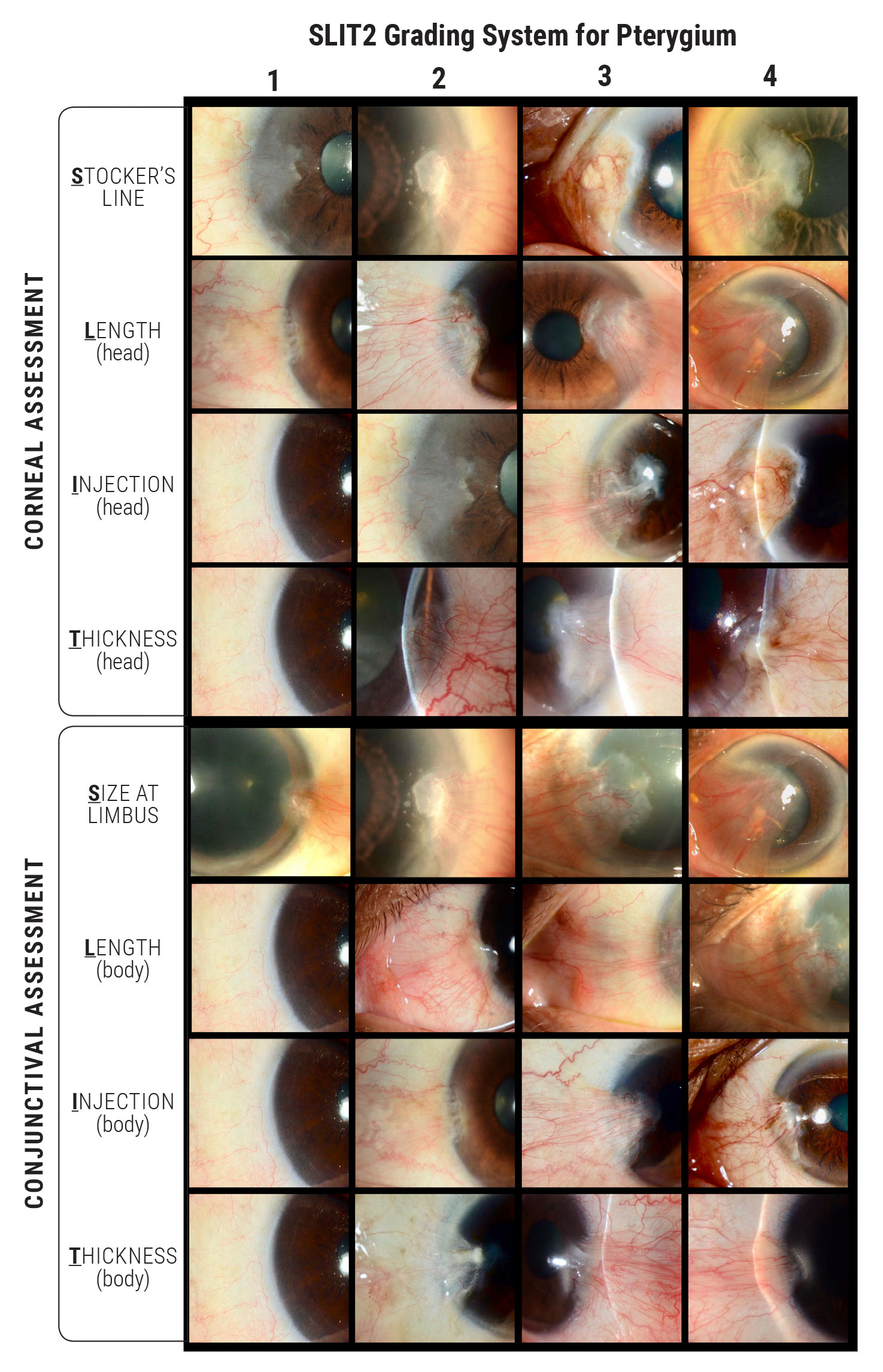Pterygium is a common ocular condition, with treatment generally dependent on the severity of the disease. In an effort to determine this metric, a team of international researchers created a multi-pronged grading system based on slit-lamp imaging that they say is an effective tool to deduce pterygium severity and occurrence.
The investigators named their grading system, “SLIT2,” an acronym for the eight parameters it comprises, four corneal and four conjunctival:
Corneal parameters:
Stocker’s line
Length of head
Injection/vascularity of head
Thickness of head
Conjunctival parameters:
Size at limbus
Length of body
Injection/vascularity of body
Thickness of body
 |
| SLIT2 Grading System for Pterygium. Photo: Jod S. Mehta, PhD, FRCOphth. Click image to enlarge. |
The study enrolled 217 patients with pterygium. All participants underwent slit-lamp exams and photography. Two graders evaluated a total of 868 independent assessments based on the 217 slit lamp images, which were divided into eight parameters. Each parameter was then assigned a score of one to-four (normal to severe). Each grader evaluated the images twice. Intra-rater and inter-rater reliability as determined by weighted Cohen's kappa analysis (κ).
Considering conjunctival assessment, the intra-rater reliability was excellent for body thickness and size at limbus, while it was substantial-to-excellent for body vascularity and moderate-to-excellent for body length. Additionally, the graders’ inter-reliability was excellent for size at limbus, substantial for body thickness and body vascularity, but only moderate for body length.
For corneal assessment, the intra-rater reliability was excellent for all four parameters and head length, substantial-to-excellent for head vascularity, but only substantial for Stocker's line and head thickness.
Currently, there are several grading systems for the assessment and reporting of preoperative pterygium severity, each with their own inherent strengths and limitations, the authors noted. The problem with these approaches, the researchers said, was that these methods generally evaluate only a single parameter of the pterygium, such as the body thickness/vascularity, caruncle morphology and corneal irregularity. Additionally, the intra-rater or inter-rater reliability of these grading systems has not been reported, they added.
The study team purposely selected graders with different levels of experience, including a medical intern and an experienced ophthalmologist, to demonstrate the consistency of this technique and how it would be applicable to other settings. In addition, the study included a mixed ethnicity cohort, in an attempt to highlight the versatility of the grading system.
Recurrence rates are much lower in modern pterygium surgery, especially if done with conjunctival autografts, says researcher Jod S. Mehta, PhD, FRCOphth, of the Singapore National Eye Centre. The reason his research team came up with the new grading system was because previous classification systems, many of which haven't been validated, attempted to link recurrence with morphology, he explains.
“Since the rates of recurrence are low, good post-op cosmesis is now really the most important outcome people want to achieve. Hence, the grading looks at corneal and conjunctival changes pre-op,” Dr. Mehta adds.
Ting DSJ, Liu YC, Patil M, et al. Proposal and validation of a new grading system for pterygium (SLIT2). Br J Ophthalmol. 2021;105(7):921-4. |

